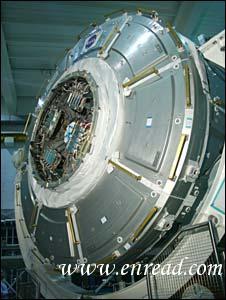| ||||||||||||||||||||||||||||||||||||||||||||||||||||||||||||||||
|
Europe has rolled out its last major module1 for the space station. 欧洲放出空间站的主模块。 Node 3 will now be flown to the US The cylindrical2(圆柱的) Node 3 - to be known as "Tranquility" - was constructed by Thales Alenia Space in Turin, Italy. Once attached to the station, it will house life support gear as well as being home to the Cupola, a giant "bay" window that was also built in Europe. Node 3 will be shipped shortly to the Kennedy Space Center in the US, from where it will catch a ride to the station in the back of a shuttle. The Endeavour orbiter flight, which will take up the Cupola as a co-passenger, is currently scheduled to lift-off in February 2010. The installation of the two European components3 will all but complete the construction phase of the International Space Station. "We still have growth opportunities," said Nasa space station manager Mike Suffredini, who had travelled to Turin to accept the Node on behalf of the US space agency. "If someone wanted to bring another module to orbit, they could - and our Russian friends do have another couple of modules4 they are proposing. But the key for us all in the partnership5 is to concentrate now on utilisation(利用,使用)," he told BBC News. Life hub The delivery of Node 3 concludes a barter6 arrangement(贸易协定) made between Europe and the US, in which Europe agreed to supply two connecting nodes, 2 and 3, in return for a free trip into space for its Columbus science laboratory. The US has already met its side of the bargain, flying Columbus to the station last year. Some 7m in length and about 4.5m in width, Node 3 is built around the same design principles as Europe's other space station contributions. Columbus, Node 2, the ATV space freighter(货船), and the Multi-Purpose Logistics Modules (which serve as the packing boxes for major re-supply missions carried out by the US shuttle) all have a similar cylindrical look about them. Node 3 has several racks inside its multi-layer, meteoroid impact-hardened shell. These bays will quickly become filled in orbit by equipment already on the station. Chief among these will be the Environmental Control and Life Support Systems (ECLSS). Their jobs involve scrubbing(擦洗) the air of carbon dioxide to maintain its oxygen concentration; and recycling waste water, including urine(尿), so it can be drunk again and again. Node 3 will also store a treadmill7(跑步机) the crew will need to use regularly to exercise their bodies and maintain bone density8. One of the risks of living in microgravity conditions is that bones tend to lose strength over time. 点击  收听单词发音 收听单词发音
|
||||||||||||||||||||||||||||||||||||||||||||||||||||||||||||||||
- 发表评论
-
- 最新评论 进入详细评论页>>




